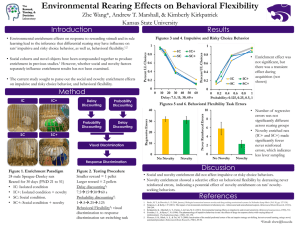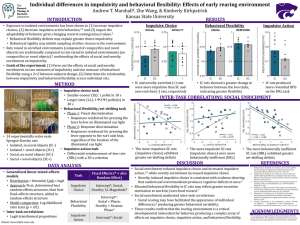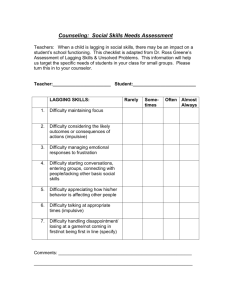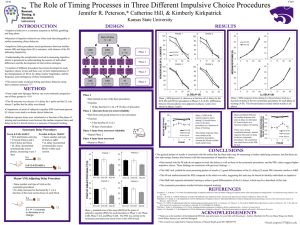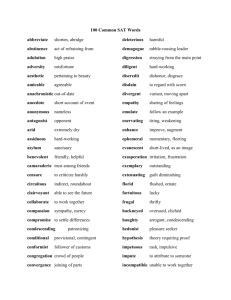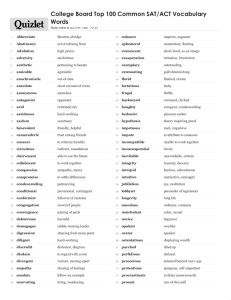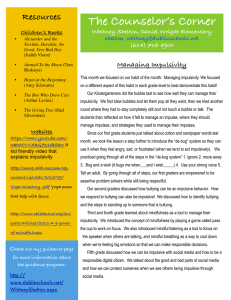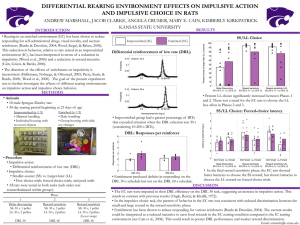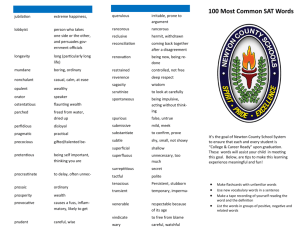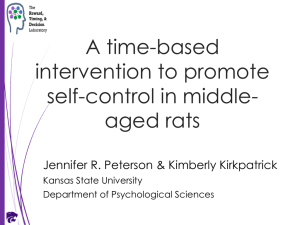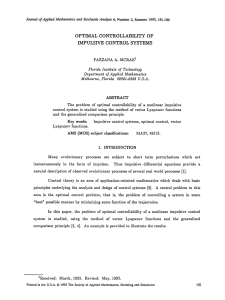Environmental Rearing Effects on Impulsivity in Rats Kansas State University
advertisement
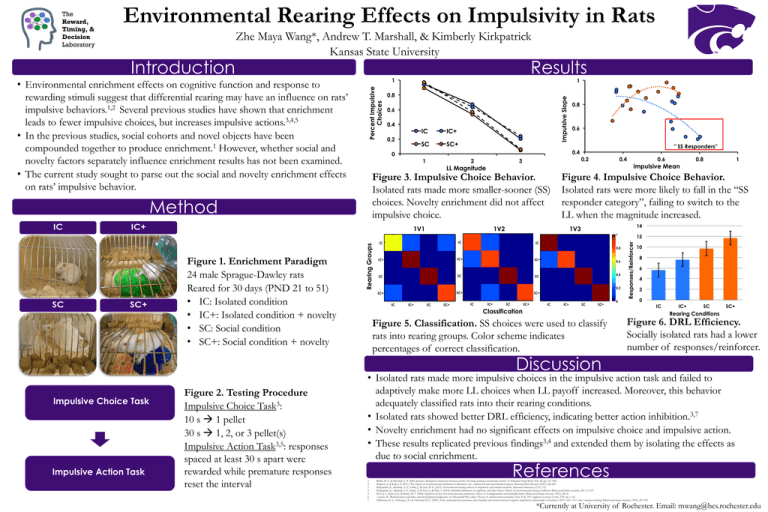
Environmental Rearing Effects on Impulsivity in Rats 1 0.8 Impulsive Slope • Environmental enrichment effects on cognitive function and response to rewarding stimuli suggest that differential rearing may have an influence on rats’ impulsive behaviors.1,2 Several previous studies have shown that enrichment 3,4,5 leads to fewer impulsive choices, but increases impulsive actions. • In the previous studies, social cohorts and novel objects have been 1 compounded together to produce enrichment. However, whether social and novelty factors separately influence enrichment results has not been examined. • The current study sought to parse out the social and novelty enrichment effects on rats’ impulsive behavior. Results 1 Percent Impulsive Choices Introduction Zhe Maya Wang*, Andrew T. Marshall, & Kimberly Kirkpatrick Kansas State University 0.6 0.4 0.2 IC IC+ SC SC+ 0.6 " SS Responders" 0.4 0 1 2 0.2 3 LL Magnitude 1V1 1V2 0.4 0.6 0.8 1 Impulsive Mean Figure 3. Impulsive Choice Behavior. Isolated rats made more smaller-sooner (SS) choices. Novelty enrichment did not affect impulsive choice. Method 0.8 Figure 4. Impulsive Choice Behavior. Isolated rats were more likely to fall in the “SS responder category”, failing to switch to the LL when the magnitude increased. 14 1V3 Rearing Groups Figure 1. Enrichment Paradigm 24 male Sprague-Dawley rats Reared for 30 days (PND 21 to 51) • IC: Isolated condition • IC+: Isolated condition + novelty • SC: Social condition • SC+: Social condition + novelty Responses/Reinforcer 12 Impulsive Choice Task Impulsive Action Task 8 6 4 2 0 IC Classification IC+ SC SC+ Rearing Conditions Figure 5. Classification. SS choices were used to classify rats into rearing groups. Color scheme indicates percentages of correct classification. Discussion Figure 2. Testing Procedure 3 Impulsive Choice Task : 10 s 1 pellet 30 s 1, 2, or 3 pellet(s) Impulsive Action Task3,5: responses spaced at least 30 s apart were rewarded while premature responses reset the interval 10 Figure 6. DRL Efficiency. Socially isolated rats had a lower number of responses/reinforcer. • Isolated rats made more impulsive choices in the impulsive action task and failed to adaptively make more LL choices when LL payoff increased. Moreover, this behavior adequately classified rats into their rearing conditions. 3,7 • Isolated rats showed better DRL efficiency, indicating better action inhibition. • Novelty enrichment had no significant effects on impulsive choice and impulsive action. 3,4 • These results replicated previous findings and extended them by isolating the effects as due to social enrichment. 1. 2. 3. 4. 5. 6. 7. References Bardo, M. T., & Dwoskin, L. P. (2004, January). Biological connection between novelty-and drug-seeking motivational systems. In Nebraska Symp Motiv (Vol. 50, pp. 127-158). Simpson, J., & Kelly, J. P. (2011). The impact of environmental enrichment in laboratory rats—behavioral and neurochemical aspects. Behavioral Brain Research, 222(1), 246-264. Kirkpatrick, K., Marshall, A. T., Clarke, J., & Cain, M. E. (2013). Environmental rearing effects on impulsivity and reward sensitivity. Behavioral neuroscience,127(5), 712. Kirkpatrick, K., Marshall, A. T., Smith, A. P., Koci, J., & Park, Y. (2014). Individual differences in impulsive and risky choice: Effects of environmental rearing conditions. Behavioural brain research, 269, 115-127. Perry, J. L., Stairs, D. J., & Bardo, M. T. (2008). Impulsive choice and environmental enrichment: effects of d-amphetamine and methylphenidate. Behavioural brain research, 193(1), 48-54. Catania AC. Reinforcement schedules and psychophysical judgments. In: Schoenfeld WN, editor. Theory of reinforcement schedules. New York, NY: Appleton-Century-Crofts; 1970. pp. 1–42. Hellemans, K. G., Nobrega, J. N., & Olmstead, M. C. (2005). Early environmental experience alters baseline and ethanol-induced cognitive impulsivity: relationship to forebrain 5-HT< sub> 1A</sub> receptor binding. Behavioural brain research, 159(2), 207-220. *Currently at University of Rochester. Email: mwang@bcs.rochester.edu
